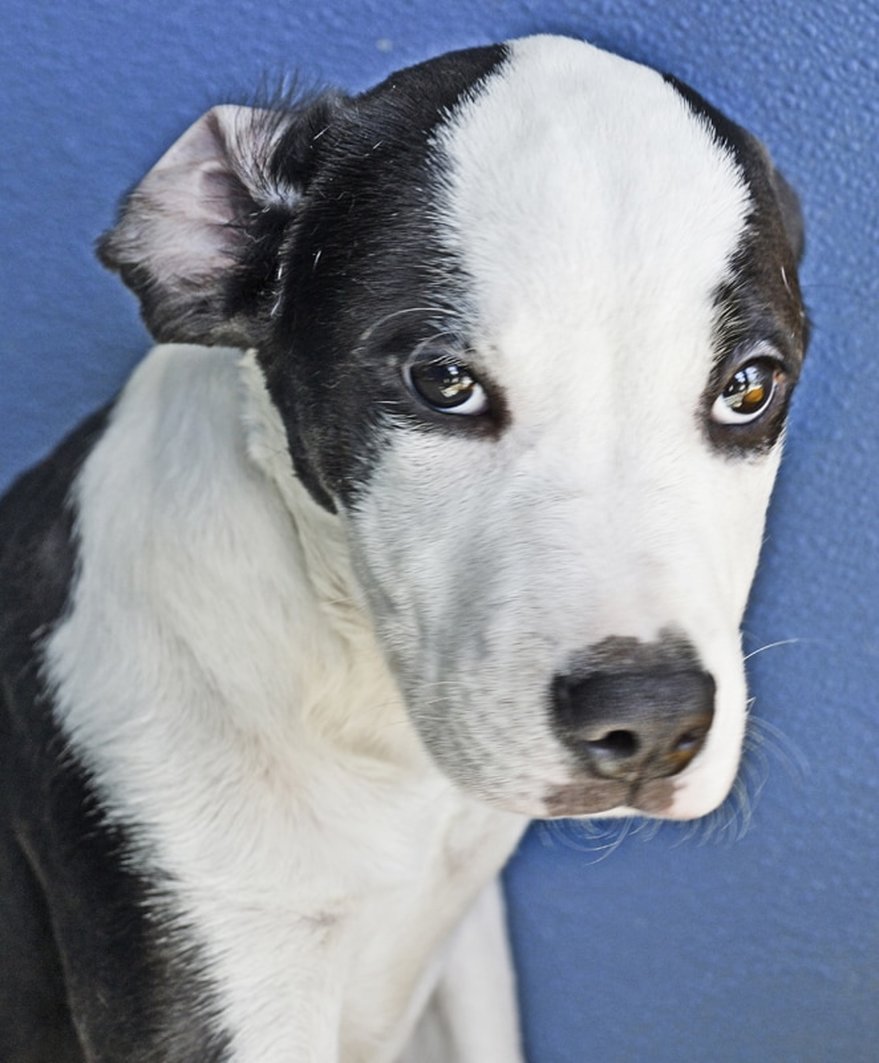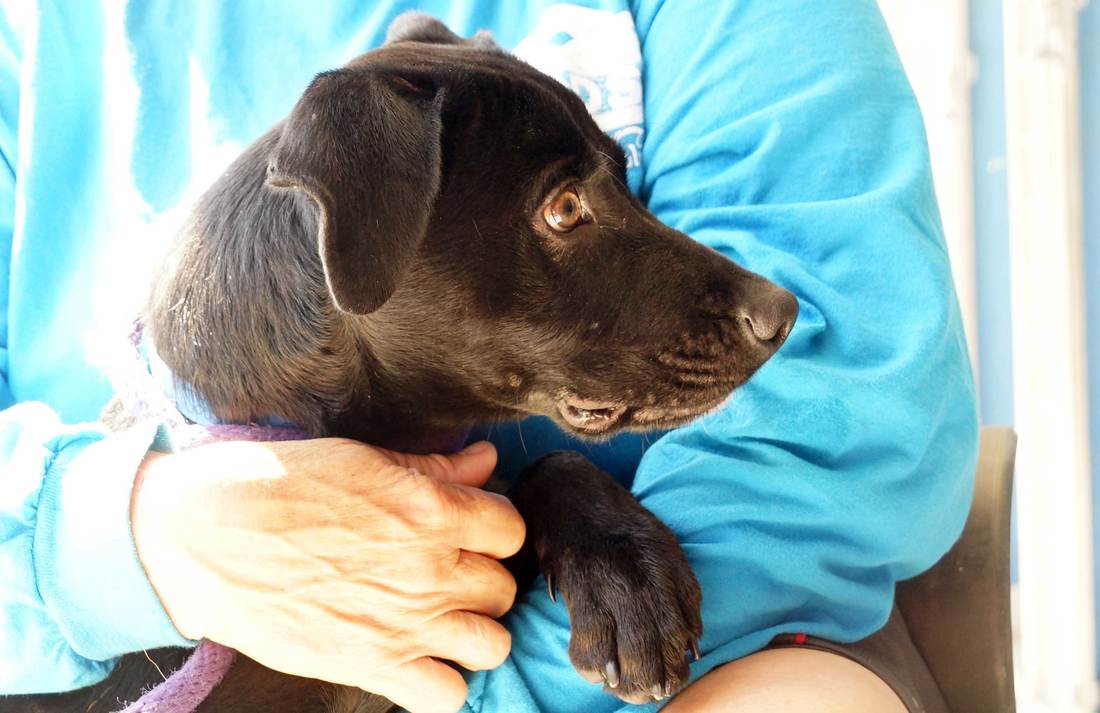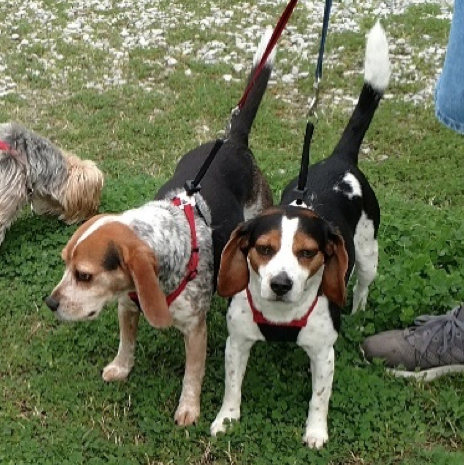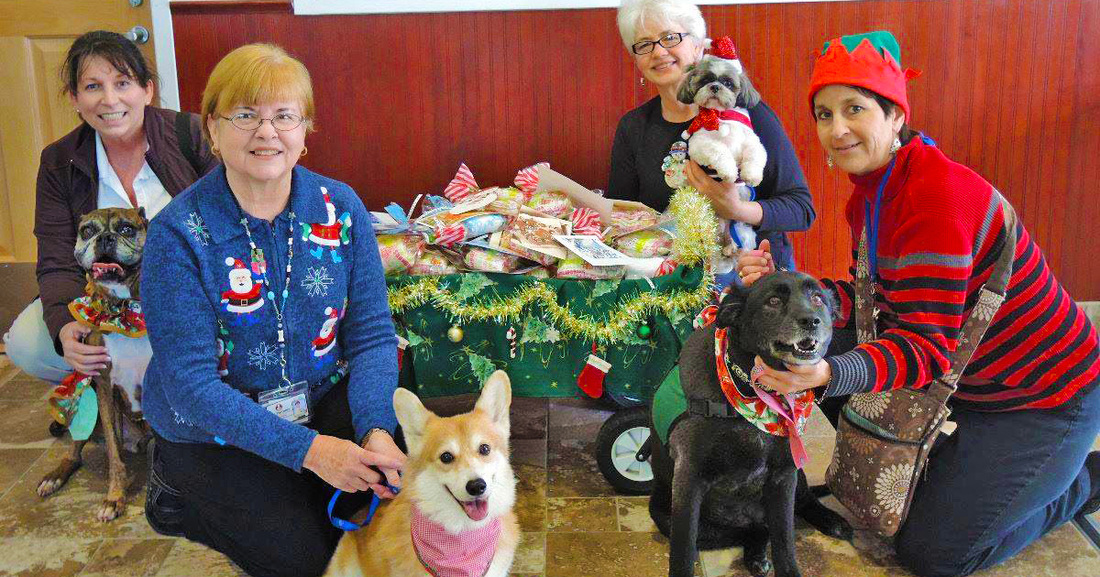A newcomer to Bay St. Louis discovers a community of local businesses and neighbors who welcome her and her Doodle sidekick to the dog-friendly town.
- story by Denise Jacobs
Linda especially enjoys eating on the porch at Lulu’s on Main (126 Main Street) with Mowgli, her mostly Finnish Spitz, at her feet. I feel the same way about the Old Town merchants, who have always welcomed Biscuit, my mini Goldendoodle.
From the beginning of my move to BSL almost three years ago, the courtyard of the Mockingbird Café has been my go-to place for meeting others with dog on leash. It’s where I met Fahey DeBenedetto House, now a dear friend. Fahey and I began talking about Biscuit, and by the time I had downed an iced coffee, Fahey had invited me to join a loosely-formed cadre of women with dogs. Before I knew it, I was on the receiving end of a flurry of daily texts: Heading out in 15. Woof! And just like that, my new life in Bay St. Louis began to take shape.
At first, I felt awkward as the newcomer. Because these women had established relationships with one another, I tried to stand back and give them space—not hard to do given Biscuit’s tennis-ball fixation. It was easy to throw one tennis ball after another and give my potential new friends space. I soon realized, however, that there was nothing cliquish about the group. We simply aligned per the configuration of the day, and the configurations varied. Once, Fahey and Karen paired-off on some swings deep in conversation while Diana and I paired-off at the picnic table, also deep in conversation. At other times, Fahey and I might walk and talk about politics, or she might tell me about growing up in Bay St. Louis, a town I was just getting to know. Rebecca and I, both writers, talked about writing. I liked to talk to Karen about yoga—a perfect topic since she had recently completed her 200-hour yoga training at Kripalu.
Between us, we had Goldendoodles (Haggis and Biscuit), Westies (Allie and Marley), and mutts (Willie and Skye). There were others—some pictured here—but I had yet to meet them. For two years now, our little pack has both expanded and diminished, and text messages come and go with varying degrees of frequency and complexity.
Sadly, Willie’s companion, Skye, died. That was a blow to all of us, but none so much as Diana, who had rescued him in the first place, and Rebecca, his undercover sleeping companion. Haggis and Karen have since moved far across the country. Deirdre of Long Beach, on vacation when I first joined the group, reappeared with her two Westies and occasional fosters. You just never know, but if you show up, we draw a circle and take you in just as the group drew a circle and took me in. Love me, love my dog is the rule of the day and more than a metaphor. We admire each other’s dogs. We let them lick our faces and climb on our backs. Biscuit places his drool-soaked tennis ball on a bench to the left of Diana. She picks it up, hands it to me (on her right), and I throw it to Biscuit. Repeat 500 times. Biscuit, a loner, has become a little more social and now happily greets his human friends if not the dogs. When Haggis’s arthritis exacerbated, we all kept an eye on him, as he didn’t seem to know when to stop. Allie began catching tennis balls of her own. The question is, will she ever return one?
One day last year, Fahey texted me that Willie could not be found. Within minutes, without hesitation, I grabbed my coat, leashed Biscuit, and began walking down DeMontluzin looking for Willie. Fahey had already been to the beach; no Willie. She and Karen were walking down Necaise. At Second and State, I turned left onto Main.
“Willie cannot have gone far,” I thought. I could see Rebecca walking around her house, the front door wide open. Diana was teaching a yoga class and had no idea Willie was gone. I knew we had to find him before Diana’s class ended in an hour. No one said it, but we all knew that Diana and Rebecca, having just lost Skye, could not take another loss. Willie had to be found before Diana’s yoga class ended. We had an hour. Biscuit and I walked up to the white picket fence surrounding Diana and Rebecca’s house. As we stood there with a worried Rebecca, a very dirty Willie sauntered up from somewhere underneath the house. He may have been digging to China. I like to think that he knew Biscuit and I were there and came out from under to say hello, what’s up? Whatever Willie’s thinking, we were all relieved to see him. Later, Rebecca texted a thank you and wrote, “I feel like the troops came out to help . . . now, that’s community!” It is community. Studies have shown that dogs can provide their owners with more than companionship; they also help create human-to-human friendships and social support. Between our dog adventures and good old-fashioned Southern hospitality, our lives here in the Bay intertwine in the very best of ways and our circle of friends ever widens.
If you've ever thought about fostering a shelter dog, this story is for you: it blows apart four common myths and demystifies the process!
- by LB Kovac, photos by Ellis Anderson
She’s a current board member of FOTAS and organizer of the shelter’s weekly adoption, which takes place every Saturday at Pet Smart. Having worked in so many roles in the shelter and in the foster community, she has a unique insight into the truths, and myths, of fostering animals.
Myth Busting
Myth 1) I don’t have enough money
Costs can easily add up when owning a pet. Even small dogs or cats require some combination of food, crate or kennel, toys, and space to play. As a pet parent, you would shoulder most of these expenses on your own. But, as a foster parent, those costs are shared with a community. The shelter and FOTAS distribute donated food, toys, leashes, and other necessities among foster parents, helping to defray costs. And what could be the most expensive part of pet ownership – veterinarian visits - are provided free through the shelter. “There’s a vet on staff, if your foster animal needs medical services, and you have access to worming medication and flea and tick preventatives, among other things.”
2) I can’t because I have other pets or kids
An important part of the fostering process is getting animals ready for experiences outside of the shelter. In the shelter, animals spend much of their time in the kennel, but, outside in the big ol’ world, they encounter all kinds of strange noises and sounds and smells. Being socialized early on, in a safe environment, will ensure that the animal can thrive once it gets to its forever home. “We welcome fosters with families and pets,” says Hines. “They can help the animals get used to interacting with other cats and dogs.” There are some preventative measures in place, to make sure that both foster animal and foster family members are all safe and healthy. Along with an application, families or individuals looking to foster an animal must demonstrate that their own pets are spayed or neutered and up-to-date medication. In turn, the shelter workers do their part to screen animals before fostering, only sending out animals that will work in a foster environment. “We never place an animal that is a medical threat,” says Hines, “and we work to make sure that they have a temperament suitable for other animals or kids.”
3) I’ll be stuck with it forever
Although some foster situations do turn into adoptions, not every foster needs to be a lifelong commitment. Some fosters are just for a few days - think pet hotel. The Hancock shelter participates in a rescue transport program, which matches adoptable animals with potential pet owners all over the country. Before these animals “fly” to their new home, they need a place to stay – a hotel room, if you will. Willing fosters can take these animals for a few days “vacation,” so they can relax while waiting to be transported. The shelter also sometimes experiences overcrowding. When space is limited, workers look to fosters to take extra animals until some are adopted or transported. “Some fosters do take much longer,” says Hines, “but the typical case lasts less than 10 weeks.”
4) They don’t need me to foster
Fostering is, according to Hines, “critical to the shelter.” Without the work of fosters, animals would die. Like all shelters, the Hancock shelter strives to be a no-kill shelter. However, the shelter is constantly walking a very thin line. “Adoption rates in this area are high, but intake numbers are also high,” says Hines. In the past, the shelter has been lucky to find short-term fosters who could take in animals until others were adopted or transported out of state. If the numbers were to tip just a little – say a few less adoptions one month, or a few too many animals found wandering the streets the next – the shelter wouldn’t have enough space or resources to provide for the animals. “We rely on the fosters; if not for them, some of these animals would have to be put down,” says Hines. If you’re interested in fostering an animal, you can contact the shelter through their website or by calling (228) 466-4516. You can also check the shelter’s Facebook page for up-to-date information about emergency foster situations. To all those who do support the shelter’s efforts, Hines has this to say: “This community is great about letting others know about the needs of the shelter… I love those animals, and I love our volunteers.”
More than 400 Hancock County dogs and cats got a new chance to find quality homes in the North last year, thanks to a lot of determined volunteers and an ingenious transport program.
- story by LB Kovac

Volunteers at the 2017 Turkey Trot run, a Thanksgiving Day benefit for Friends of the Animal Shelter. LtoR: Left to right: Billy Rappold (transport driver/Friends interim President), Helene Johnson (Turkey Trot organizer), unnamed volunteer, Penne Rappold (Friends treasurer), and Denise Hines, holding dog.
Denise Hines is a volunteer with Friends of the Animal Shelter, a non-profit organization that supports the Hancock County animal shelter. The group focuses much energy on public awareness and raising money for free spay-neuter vouchers to reduce the number of throw-away pets.
Friends volunteer work ranges from spreading the word about adoptable pets on social media, to playing foster parent to new puppies, to simply playing a round of fetch with a bored dog. Hines also drives the van.
Friends of the Animal Shelter partners with Animal Rescue Front, Inc., or ARF, a Massachusetts-based organization that pairs full shelters in the South with emptier ones in the North. It helps overcrowded shelters like Hancock County's transport dogs and cats to shelters where there is a 100% adoption rate.
“We transport them into areas where there are almost no ‘disposable animals,’” says Hines. Once a month, she, as well as a few other dedicated volunteers with Friends, pack up a big blue Ford Transit van with adoptable dogs and cats for the first leg of a cross-country trip out of the South. Their first stop: Madison, Mississippi. “Rescue groups from across the region converge there,” says Hines. The animals ride in crates in the back of the van, with Hines and other drivers making frequent stops to clean the van, get humans and pets a snack and allow everyone a moment to stretch their legs. From there, Hines says, “[Animal Rescue Front, Inc.] drivers take them up North.” Some animals will go to shelters in Virginia or Massachusetts, but some might travel more than a thousand miles to shelters as far away as Maine. Friends coordinates similar trips with other transport groups too. It’s a long trip, but well worth it, both for volunteers and their furry passengers.
Below: Just a few of the Hancock Shelter dogs that were saved by transport to the North in 2017.
Potential adopters in most northeastern states have to jump through lots of hoops to adopt a puppy or kitten. There are home visits and lengthy applications to fill out. There’s often a requirement that every member of the family must pledge that they want the pet. Adoption fees are in the $400 range.
Even with these strict requirements for adoption, many of the dogs and cats that make this trip north are adopted before they even arrive at their destination shelters. Last year, Friends of the Animal Shelter was able to save more than 400 dogs and cats by transport. While transportation is a partial solution for the Hancock County shelter’s overcrowding problem, it still costs money. Each pet needs to have necessary shots, and tests for heartworms and infections, in addition to being conditioned for crates, transportation and family life. None of this is provided by the county or the state; it is all funded by private and corporate donations. “Thankfully, the community is supporting it,” says Hines. And that support (you can donate online now by clicking here!) is gladly welcomed because the other option, euthanasia, is unthinkable to the volunteers, who have seen too many worthy dogs meet their untimely ends. Many shelters, like Hancock County’s, resort to euthanasia at times because there simply aren’t the resources – food, money, volunteers, medication and space – needed to keep animals healthy until they are adopted. But both transporting pets out of state and euthanasia are merely stop-gap measures.
According to the ASPCA, Mississippi has no statewide laws that require the spaying or neutering of animals before licensing or adopting. Hines argues that such lax regulations create an excess supply of unwanted animals.
“In the North, many places require a renewable license for any pet; to obtain it, you have to be current and up-to-date on vaccines, and the pet must be spayed or neutered,” Hines says. “Puppy mills simply don’t exist in these states. To license a dog that’s not spayed or neutered, people have to meet official requirements to become certified dog breeders.” An NPR piece featured on “Morning Edition” points out empty shelters are now common throughout New England states and the whole of the Northeast, thanks to government programs: “spay and neuter programs, combined with strong participation by rescue groups, have greatly reduced the number of unwanted dogs” in these areas. Once sterilization became a normal part of the pet adoption and licensing process, there were fewer unwanted and abandoned animals in those states. Volunteers believe that if Mississippi were to adopt similar laws, the number of “unwanted” animals in the area would likely eventually fall to numbers that the local shelters could manage. The need for pet transportation groups and putting down sick or injured animals would become the exception, rather than the rule.
And stricter cruelty laws would not only dole out severe punishment to offenders, they would change the cultural norm of what's acceptable.
“If the government has respect for the animals and strict penalties for animal cruelty, that’s eventually reflected in the attitudes of the residents," says Hines. But until that happens, volunteers like Hines welcome the continued support of the community in getting these pets to the loving homes they deserve. Hitting the road, in this case, saves hundreds of lives each year. Road Trip
Robbie MacDougal, Shetland Sheepdog and canine journalist, lists eight "rules of the road" to follow when you're traveling with your pet.
Rule Number 1:
Make being in the car a fun experience. Trips to the vet do not count. Take us for a fun ride in the car and go to the beach. When we are in the car see how we do. Are we nervous or do we get a little car sick? Getting a benchmark of how we do is very important. You know how I am going to do for a short trip and you know how I will do on a long one. Rule Number 2: If your pet is a dog, get a harness/safety belt. In an accident or emergency you need to know we are safe. In many accidents, non-restrained or non-harnessed dogs go flying and are killed or lost. Cats need to be in carriers. The best ones are durable and smooth edged with ventilation and a secure door.
Rule Number 3:
Check with your veterinarian. Are we healthy and up to date on shots? If yes, plan to have a copy of the records and the rabies certificate. Any allergies or carsickness issues to have medicine for? If you have a regular vet, you can log in to www.vetsource.com and get meds while traveling. Ask your veterinarian about this service. Rule Number 4: Plan ahead. Where will you stay? Do they allow pets and is there a cost and rules of behavior? There are many websites that tell you about pet friendly hotels like www.goPetFriendly.com. Or www.bringfido.com or www.aaa.com/petbook . You can find cities and locations that love your pets, parks to visit, pet friendly restaurants and meet-up groups. If you are staying with friends or relatives, be sure you find out their house rules and abide by them – if you want to be invited back.
Rule Number 5:
On the trip plan to stop frequently for potty and leg stretching breaks. Always put your pet on a leash and know what the plan is for eating and people bathroom breaks. Never leave a pet in a car on a hot day while you go in to eat. You may have to plan for taking food in the car and stopping at rest stops for eating. Rule Number 6: Packing for your pet is like packing for you or your children. Think of everything you need. Bowls for water and food, leashes, blankets and towels, bedding, litter and litter boxes for the cat travelers, a first-aid kit, food, and treats, etc. Think about where you are going to be, at a friend’s or relative’s home or camping or just a long road trip. If you are flying you will need to check with the airlines for all their requirements. Planning ahead and thinking of all the possible scenarios will make the trip fun for all. Pinterest has a large collection of grab and go bag suggestions.
Rule Number 7:
ID, ID, ID. Have a collar with tags, use microchips, and have a photo of your pet and a photo of you with your pet. Using a carrier? Have ID on the carrier. Always have a grab and go bag that has all the documents you need and instructions on medications and what to do if you and your pet get separated from each other – meaning who to contact and instructions on care. Rule Number 8: Have a disaster plan in place. Where will you go and what will you take. Have a pet first-aid kit handy, all the documents you need and all the supplies you need. Print out this Red Cross Ready Pets and Disaster Safety Checklist. This is one of the best because it tells you about preparation, what you need to do and what to do as the disaster approaches. Almost as important is what to know to do after a disaster. Many animals, just like people, suffer from the trauma of the event and need extra care. Traveling with a pet can be a nightmare or a joy. Do your preparation and you will have a wonderful experience. Love Lasts Longer With Pets in the Picture
Robbie MacDougal, Shetland Sheepdog and canine journalist, looks at research revealing that pets - and even photos of them - can improve a marriage.
A new study funded by the U.S. Department of Defense as part of the Military Research Consortium explores the role of evaluative conditioning as a path to strengthening marriages and their support systems. Why this is of interest to our understanding of the human-pet companion bond is that animals were an important part of the research.
The Association for Psychological Science reported that a group of psychological scientists, with James K. McNulty of Florida State University leading, developed a method for helping marriages that is not a surprise to me: pictures of puppies and bunnies.
Researchers brought in 144 married couples, all less than 40 years old and all married less than five years, and assessed their feelings about their spouses. They showed participants pictures of their spouses, followed by negative and positive words or images, and asked them how they felt about their partner.
Then they showed the participants a slide show once every three days for six weeks. Half were photos on a split screen with the spouse and positive images and words like incredible and wonderful. Half saw the split screen with neutral photos of things like chairs and neutral words. Every two weeks for eight weeks the researchers measured attitudes and asked them how they felt about their spouse. What this study measured was based on the concept of evaluative conditioning, which simply means identifying something or someone with a feeling, good or bad, that sticks with the something or someone. You may have experienced this, for example, when you’ve eaten something, gotten sick, and forever hated that food. Another example happens when you identify a memory with a song. You hear a song, and you go back to a place or a time, maybe with a certain person.
This is where the bunnies and puppies come into the research. Hoping to retrain how spouses felt about each other, the researchers showed participants images of their spouses paired with positive words or images (the bunnies and the puppies) over a period of time. The theory was that the positive feelings would enhance positive feelings toward partners.
The intervention worked, and marital satisfaction was improved. James McNulty and his associates were a little surprised at how effective the images were. McNulty was quoted as saying, “It was like they went on 13 artificial good dates.” I am not surprised at the results — nothing is better than puppies and bunnies. The overall takeaway is that you associate friends, spouses, siblings, and coworkers with positive and negative thoughts and experiences that will influence relationships. Let us be a part of the positives in your relationships. Not only looking at pictures of puppies and bunnies, but also having them in your life will make your relationships more satisfying. Just another way we make your lives better! Keep your tail high and your feet dry and think aboutadopting a pet from the shelter. I, Squirrel
Robbie MacDougal, Shetland Sheepdog and canine journalist - and longtime watcher of squirrels - takes a closer look at these frolicsome creatures, including Pete, President Truman's White House squirrel.
Next I read a tiny item that squirrels were once one of America’s favorite pets. One in particular, Pete the Squirrel, belonged to President Harry S. Truman.
When I researched squirrels as pets I found an article at atlasobscura.com that confirmed that squirrels indeed were popular pets. Mungo, for example, was a very special squirrel who belonged to Benjamin Franklin. When Mungo was killed by a dog, Franklin wrote, “Few squirrels were better accomplished, for he had a good education, had traveled far, and seen much of the world.” Katherine Grier’s book Pets in America noted that while colonial Americans kept many types of wild animals as pets, squirrels were the most popular. By the 1700s squirrels were the rage — they were kept in fine homes, clothed, fed well, and often even appeared in the ubiquitous family portraits. Eventually the fad of ownership lessened. They were, after all, wild animals, and behaved as such. Many states in the U.S. now have laws on the books prohibiting keeping squirrels at home. Squirrels still have a big place in our hearts, so there is National Squirrel Appreciation Day on January 21. To help you better appreciate these backyard critters, here are a few facts and thoughts on squirrels: Recognize these two fellas? They are the infamous Disney characters Chip and Dale. 
To help you better appreciate these backyard critters, here are a few facts and thoughts on squirrels:
Recognize these two fellas? They are the infamous Disney characters Chip and Dale. Did you know that chipmunks are rodents and members of the family Sciuridae, just like grey squirrels? There are around 280 different species of squirrels, including gray squirrels, red squirrels, chipmunks, fox squirrels, marmots, and groundhogs. Betcha didn’t know there were so many. There are a lot of famous squirrel characters. See if you remember these characters compiled by ranker.com. To test your knowledge of squirrel trivia, check your answers to these questions at the National Wildlife Federation blog:
If you have children in your household, one of the best ways for them to learn about squirrel and other backyard habitats is using resources from the National Wildlife Federation. Ranger Rick is one of the best.
I want to be fair to my gentle readers who do not see squirrels and their relatives as benign, fun, lovely additions to the backyard environment. One of my neighbors sees them as enemies to be thwarted, and pesky rodents who steal birdseed from feeders. The World Wildlife Fund has some tricks for slowing down squirrels like weight-activated feeders, a feeding station just for the squirrels, and various baffles.
Keep in mind that squirrels are very resourceful, and that young squirrels learn from their mothers and grandmothers in attacking your feeder. Whatever you feel about squirrels, my advice is to get a good comfy chair and position it by the best window in the house and watch them perform. Love, Robbie Snowbird Dogs (and Cats)
Robbie MacDougal, Shetland Sheepdog and canine journalist, introduces a few of the regular winter time pet residents of Bay Hide Away in Lakeshore. Most will be headed north soon. See you next year!

Silly from Wisconsin
My cat Silly, she can love you one minute & hiss at you the next. She loves to travel in our motor home. Silly sleeps on a rug on the dash and sometimes she even wants to drive. She loves Bay Hide Away Campground. She loves to watch the birds & has lots of sunshine for all her naps. Silly's quite vocal when she wants to eat, especially at 2am. But all in all, we wouldn't trade her. She's our little girl. 
Marco Polo from USA
This is my mugshot from the paper shredding incident. But I was framed, the cat did it! After my rescue from Alabama and transport to Connecticut, I found my forever home. I now travel the country in a travel trailer (which is a whole lot easier to guard than a house) with my human. I get to sniff new places, score treats from new neighbors, and ride in a truck. But the place I have the most fun and spend the most time is Bay Hide Away. It's nice to have a place to come home to when you're 'On the go'. Marco Polo.
The next time she wouldn’t come back in! I would see her outside the door but she would run and hide as soon as I opened the door. After three days, we had to trick her and catch her in a live trap. She stayed inside for the rest of our four-month stay.
This year, when we came back to Bay Hide Away RV Park, we worked with her outside during the day again, letting her explore near the motorhome. Now she is happily sleeping all day inside and going outside at night.
This is the place to be for all of us who live here full time and those who come and see us. Who knows the next dog you see walking down the street on the end of a leash could be from Michigan or Wisconsin or Iowa – anywhere.
Gentle readers, Daisy told me I need to end with her special sign off so, keep your tail high and your feet dry. Love, Robbie This and That About Cats and Kittens
Billions of songbirds and small mammals are killed each year by outdoor cats - both feral and those that are pets. Find out about local programs that are working to spay, neuter and find homes for felines in Hancock County.
- Robbie MacDougal, Shetland Sheepdog and canine journalist
One of the things on my mind is what to do about cats and kittens. It is getting to be kitten season. Actually in Mississippi we have kitten seasons in the spring, late spring and fall. That means full shelters and many feral kittens.
When it comes to cats and kittens, I am not surprised that we have so many in Hancock County. “Ten thousand years after their ancestors invaded our Fertile Crescent settlements, house cats — tailing our armies and sailing on our ships — have spread like dandelion fluff,” according to an article in the October 2016 Smithsonian Magazine (Abigail Tucker: “To Save the Woodrat, Conservationists Have to Deal With an Invasive Species First: House Cats”).
The U.S. has an estimated 80 million feral cats and another 100 million pet cats — a number that has apparently tripled in the last 40 years. Females reach maturity at 6 months. Some can breed at 4 months. The calculations show that a breeding pair of cats could produce 354,294 descendants in five years, if all survived. Gad! That is a lot of cats.
Here in Hancock County we have house cats who stay indoors all the time, cats who come and go, and feral cats. In our household all the cats are rescues. They are all spayed or neutered and never go out, so they don’t add to “cat issues.”
My neighbor has a couple of outdoor cats who are neutered and are up-to-date on their shots. The only issues they could cause are if they go after the local birds. Did you know that house cats kill somewhere between 1.3 and 4 billion birds every year in the U.S., according to the Audubon Society? Feral cats kill another 2.4 billion birds and 12.3 billion small mammals. Yipes! Some people put bells on their cats, and other have used a BirdsBeSafe collar. This is a neat idea that my neighbor told me about. Her cat collars are the breakaway kind with reflective tape. 
I’m not saying that all cats would be willing to wear such a collar, but bringing the subject up does remind us all that cats do kill a lot of birds.
Then we have another category, feral cats. These are cats who are born and grow up in the wild. Some cats are abandoned and turn semi-feral. The problem is that if they are not spayed or neutered they will produce lots and lots of kittens. One of my neighbors just picked up a trap from us to catch two male cats who have been living under their porch. The neighbor will use one of the Friends of the Animal Shelter in Hancock County free spay/neuter vouchers to make these two cat fellas unable to be dads. No more yowling, and less fighting and fewer kittens. The Trap/Neuter/Release program has helped, but more of these free roaming no-owner cats need to be fixed. If you are a cat lover, I invite you to think about what you can do to help. All of your cats should be fixed so they cannot reproduce. We brought in one feral cat we were unable to touch for over a year. She roamed and hid in the house. Boo did well with the litter box but as she was not spayed we began to notice a kitchen curtain that was yellow on the bottom. We had to trap her to get her spayed to stop the spraying. Outdoor cats need to be fixed as well. Friends of the Animal Shelter in Hancock County has no co-pay (that would be free) spay and neuter vouchers available for indoor, outdoor, and feral cats. Visit friendsoftheanimalshelter.org for additional information. FYI, they also have vouchers for dogs. Another thing cat lovers can do is to make room for just one more. There are so many lovely cats who wind up in shelters and who need good homes. The Hancock County Animal Shelter Facebook page lists available cats and kittens. Like this one! Thank you for reading my first column. I think I need a sign-off, so here goes: Love is all there is — spread it everywhere! Robbie What a Ride!
A tribute to a remarkable rescue dog and Shoofly columnist, Daisy Mae, who passed away in January. Daisy Mae, we won't forget you.
- by Christiana Richardson, PhD
In addition to being a management consultant, I am also a grief counselor. Many a client has been helped by having Daisy sit next to them while we talk. Daisy worked with me at the American Red Cross – responding to emergencies where she would sit with the children to be a calming force - a mannequin as we taught pet first aid. Sometimes the participants had her so bandaged that only her nose was sticking out.
Together we wrote about and talked about issues that matter – not just to animal people but to everyone. Taking care of and loving and being loved is a gift not to be taken lightly. We are who we are because of the love in our lives. Make room for love and love in return. This morning my constant companion of 15 years died in my arms. I will love her forever. I hope that you have had and will have the gift of unconditional love. I will cry with my friends and I know how lucky I have been. As Daisy said – dear gentle readers keep your tail high and your feet dry! Puppy Dog Tales will go on – Daisy’s brother Robbie will be writing. I expect a rougher edge as he is a dominate male. Here is a photo of him last year with Daisy in her Micky Evans bustier. Mikey is not one who dresses up. Too frivolous!
The sign on her cage read: 13 months old, excessive barker, not housetrained. Her chances of survival were slim until Lost Dog and Cat Rescue saw her. She was spayed and then taken to the PetSmart in Alexandria, VA.
I just happened to be there getting cat food and this dog walked over to me. She was up for adoption and it took about 20 minutes until she was mine. Two days after joining our family she got very agitated, tugging at me and whining. Shortly thereafter I had a seizure. She had alerted me. After doing this twice more my doctor said she had the gift and she became my registered seizure alert dog. From this day forward she has been my constant companion and a game changer in my life. I was a management consultant and Daisy went with me. We stayed in hotels and ate in their restaurants. Daisy liked the tables with tablecloths to the floor and we wrote an article for the hotel magazine about that. Soon we were writing for numerous papers on all things animal. Daisy got such a good reputation that I was asked to also do some writing. I became a journalist writing on many topics and Daisy and I have been on the masthead of three newspapers and a columnist for the Shoofly Magazine. The Dog Days of August
What do dogs think about during the summer when it's too hot to go outside and play? Daisy Mae, columnist and seizure-alert dog, clues us in.
Your words give me much to think about. One thing that I ponder on is how utterly dependent you humans are on us when you express yourselves. References to animals are ingrained in your day-to-day commun
Now as for you humans and your inclination to mess with our heads, it is my belief that you spend an inordinate amount of time dressing us up, putting odd things on our bodies and taking photos. Flattering to get the attention but strange behavior for us to behold and endure. I found this video on YouTube that highlights Halloween costumes.
Now as for you humans and your inclination to mess with our heads, it is my belief that you spend an inordinate amount of time dressing us up, putting odd things on our bodies and taking photos. Flattering to get the attention but strange behavior for us to behold and endure. I found this video on YouTube that highlights Halloween costumes.
Look at the faces on the pets and the people. Who seems to be having the most fun? Who are the adults here? Wow! This is fun. On behalf of my fellow named animals I’m feeling pretty important. We really are the center of your world.
Here are a few tips you may want to follow. I am making sure that I do not go out in the heat of the day. When I do go out I pick a spot with shade or I do not venture out. I don’t wear shoes, so pavement is hot! Walks early and after sunset are all my feet can handle. If I can’t go into a building I refuse to be left in the car. A girl could get in heat stroke territory or worse in just a few minutes. I drink plenty of water, changed frequently during the day. Groady grows quick in warm water. I get an allergy bath once a week and a good daily brushing. Then there is always the pool! Parrot Love
Two birds change the life of a Bay family, who discover while parrots demand intensive care, they give as good as they get.
- by Daisy Mae Delray, columnist and registered seizure alert dog

Teddy Boy is a Grey Amazon Parrot.
Both of these birds lived in Georgia. When their owner Raymond died unexpectedly in December 2015 they moved here to Mississippi to live with Mark and Lael Butler. Mark is Raymond’s brother so Mark and Leah had known the boys for more than 15 years. Mark told me that it hasn’t been easy for him and Lael, or the parrots — or their three dogs. First, the physical reality of moving them from Georgia to Mississippi, the very strangeness of a new home with large and loud dogs, and Mark and Lael as newbie parrot parents. But they say it has been a rewarding journey despite the challenges. “Although we’ve known the birds for 15-plus years, it is really different to be their caretaker, providing fresh fruit and veggies, two per day along with fresh water and seeds, fresh paper in their individual crates as well as the floor of their brand new aviary. In the living room, no less!” Mark told me.
Mark told me that they take the crates outside on a weekly basis to give them a good cleaning, and to give the boys some fresh air and exposure to the outdoor birdies.
These parrots have large vocabularies. “I wish you could hear the whistles, TV tunes, and the phrases like ‘scratch my head,’ ‘what’s your problem,’ or ‘hold on, buddy.’ They whistle the theme some from ‘Andy Griffith’ and ‘Bridge over the River Kwai’ and of course the classic ‘Old McDonald Had a Farm.’”
I know there are lots of parrots around, and I did some research. Did you know that there are 372 species of parrots? They are mostly tropical, subtropical and come from areas of South- and Central America, Asia, Africa, Australia and New Zealand. Species include: Macaws, Amazons, Keas, Kakas, Lorikeets, Parakeets, Love Birds and Cockatoos. Because of their beauty and intelligence, parrots are one of the most popular pets in the world. Humans learn a great deal by studying parrots. Dr. Irene Pepperberg conducted a 30-year study on parrots with her first hero parrot, Alex. She wrote about her study in the book “Alex and Me: How a Scientist and a Parrot Discovered a Hidden World of Animal Intelligence — and Formed a Deep Bond in the Process.”
Dr. Pepperberg is the founder of the Alex Foundation. Its goal is to support research and encourage responsible ownership of parrots, their conservation and preservation in the wild, and to keep pet birds healthy living with their human companions.
What a gift Handsome Jack and Teddy Boy are. I appreciate learning about them.
To learn more about these wonderful birds and how they have bonded with humans please check out these websites: National Geographic Parrot page ParrotParrot Species Guide Gentle readers, keep your tail high and your feet dry. Love, Daisy Mae Using Massage to Check Your Pet’s Well-Being
Pets love massage as much as people do. Here's how you can relax your dog or cat, while giving them a checkup.
- by Daisy Mae Delray, columnist and registered seizure alert dog
Before you begin the massage you can do a diagnostic massage to check for abnormalities. A friend of mine who has a Persian cat with lots of hair found an abscess on her cat, just under the armpit. We had shown her how to do a diagnostic massage a few weeks before so she was able to avoid a major infection.
A diagnostic massage is a simple technique every pet owner can do. It simply means feeling all over your pet’s body with a light touch, noticing any parasites, warmth, coolness, sores, swellings, tumors, discharge; anything out of the ordinary or anything your pet seems sensitive to. If done on a weekly basis, your hands and eyes will know when something has changed that you need to pay attention to or to seek veterinary help with. This is a suggested guideline of how you can do this type of massage. You can do this in any order you and your pet prefer. ●Start by touching your pet’s head with both hands and run hands down your pet’s cheeks and mouth. ●Look into their eyes and mouth, sniff for any off odors, look for marks, discoloration, chipped or dirty teeth. ●Feel around ears for lumps, hair mats, and other abnormalities. Look and sniff in the ear. ●From ears, move hands down their necks to the throat. Check for abnormalities, tenderness. ●From the throat move your hands down their chest, shoulders and front legs. Flex the legs, check the feet. ●Move your hands from the feet and down the back, sides and stomach, feeling for warmth, coolness, or anything unusual. ●Check rear legs and feet the same way you did the front. ●Feel and look at the rear area, around and under the tail and underbelly. Look for parasites, discharges and sniff for off odors. Keep a journal of what seems different. You can use this with the vet. Be sure to check weight periodically. Watch your pet walk, both towards you and away, looking for stiffness, pain, or abnormal gait. Don’t forget to monitor stool production and consistency, and urination habits and flow. You are using your eyes, your hands, and your nose to imprint a baseline impression of your pet’s body. Once you have done this a number of times you will notice something that is off normal. Keep your tail high and your feet dry! Love, Daisy Mae Homeward Bound
A unique program that transports dogs to good homes in the North is helping keep the euthanasia rate at the Hancock Animal shelter close to zero.
- by Daisy Mae Delray, columnist and registered seizure alert dog
Bookworms Are Not So Icky...
A unique volunteer program kicks off its seventh year of reading books to children in classrooms. This year - to Daisy Mae's delight - the theme is animals.
- by Daisy Mae Delray, columnist and registered seizure alert dog

I asked Kathy Wilson, Chair of the committee and Hancock County School District Community Relations Director, why the animal theme this year.
“We picked animals because they are wonderful,” Wilson said, “and because we are an animal-friendly community. Pets even have their own Mardi Gras and share our lives in so many ways.” Here is how the program works. Sponsors and readers sign up to read and to purchase three animal-themed books for each class that will be read to. That adds up to about 50 classrooms, 1,500 students, and 150 books. Wow! Each book has two stickers, the first of which reads, “This book was donated as a part of the Hancock County Chamber of Commerce Bookwork Program.” The second sticker is individualized. For example, in the books I donated it reads, “This book donated by Christina Richardson & Puppy Dog Tales in memory of Mikey MacDougal.” The class gets to keep all three books to add to the collection from the past six years of the program. We were assigned to a third grade class at North Bay and given our books. We have emailed the teacher and she will work with us to find the right days and times to get all three books read before the end of the year. With the permission of the teachers, readers are encouraged to bring their pets to the classroom. We are to have read the books before going to the class, and we have homework too. There are lesson plans available online for the books we are assigned. In addition to reading the book, we are to ask the students questions that get them interested in the subject. We also make sure they hear the name of the author and illustrator, and we are sure to be enthusiastic and patient. Reading aloud is one of the best ways to create lifelong readers. The Read-Aloud handbook and Jim Trelease’s website give many reasons why reading to children is beneficial. Another wonderful source is Reading is Fundamental. We are really excited to be a part of this wonderful Chamber program, especially with the addition of us animals in the mix. In an alliance between Friends of the Animal Shelter in Hancock County and the Boys and Girls Club, the Hancock County Library program “Reading with Friends” has students reading to the dogs. Now we get to read to them. Bonding over reading is wonderful. Please read to your children with the pets present and then let them read to you and the pets too. These will be precious memories and will help lead to a lifelong love of reading and of us pets. Keep your tail high and your feet dry! Love, Daisy Mae The Dog Chapel and Angel's Rest
Two extraordinary places pay homage to the lasting love between dogs and their human companions.
- by Daisy Mae Delray, columnist and registered seizure alert dog The Adventures of Beatrix Potter
This month, Daisy Mae (our columnist and registered seizure-alert dog) introduces neighbor rabbit Beatrix Potter, a "house rabbit."

“She was young when we got her on Mother’s Day and we quickly realized that she was very different from the other 10 rabbits we’ve had. She is very interactive and vocalizes much more than our other rabbits did.”
Rabbits are very social and get bored without companionship. Just picturing one bunny in a hutch in the backyard is a sad thought. Shawn told me that as a solitary female Beatrix needed to imprint on someone, so she now considers Shawn and Woody her fellow rabbits. Woody is her soulmate and she misses him when she goes to work. She growls, and she has a funny whimper she uses when you pick her up to bring her back inside that says, “I wanna stay outside.” Beatrix is litter box trained and considers the entire house her warren. When people realized they could litter-train, rabbits became indoor pets. They quickly become integrated into a family's day-to-day activities and add their own special personalities to the mix.
Ms. Beatrix is fond of hopping from rug to rug, her little furry feet never touching the hard floor. Because rabbits need to dig, it is very important for a house bunny to have time outside — in a safe environment, of course. If that isn't possible, watch out for your furniture and your carpets.
Ms. Beatrix loves to play, and one of her favorites games is chase. She begs to be chased and to chase. She has a favorite toy. When she gets up in the morning and is let out of her crate she goes for her pink ball which she throws, chases, cuddles and loves on. If you are considering a bunny for your future think about getting two so they can keep each other company. Having just one like Shawn and Woody do is fine if you take that hour or two a day for bunny time. If you think a bunny might be a good addition to your family consider checking out the House Rabbit Society, and watch the video below. Visiting Pet Teams of South Mississippi
This month, Daisy Mae (our columnist and registered seizure-alert dog) introduces an organization made up of pets and their peeps who volunteer to make the world a better place.
One of my jobs was to go on emergency calls, like fires. While Tina was interviewing the people I was sitting with any children or elderly people in need of a little emotional support. It was amazing to see how much I was able to calm them down and distract them. A good hug and a head on a lap goes a long way.
As I have related we service dogs are pretty special and I also have the honor of being a therapy animal too. Therapy animals work with a handler/partner to provide support to people who need comfort and help with their therapy, and mental stimulation. Unlike service animals who can only be dogs or horses, therapy animals can be dogs, horses, cats, rabbits, birds, guinea pigs, llamas/alpacas, pigs and rats. Whoda thunk it! Please watch this short video on Pet Partners and then I will tell you about our team here on the Mississippi Gulf Coast.
Pet Partners is the parent organization of our own visiting Pet Teams of South Mississippi Pet Therapy Group. I found in my reading that for more than 40 years organized animal- assisted therapy has been helping people in hospitals, nursing homes, assisted living centers, and at other venues. Nationwide more than 11,000 animals visit more than one million people in a year.
Visiting Pet Teams was organized in 2009 and now has 32 active members. Only one, Patsy Thomas, the coordinator is in Hancock County. They are recruiting new members so the program can expand. Ms. Thomas would love to tell you about the program and the requirements for handler and animal. She can be reached at 228.265.0336 or by email. Their website gives you information on what is required – they need a friendly animal with basic obedience training, a clear health record, and training specific to the program. There will be a new member orientation on Saturday, January 9th at 9:30 a.m. at Gulfport Memorial Hospital. Contact Patsy Thomas for details.
The idea of working as a team with your pet is cool. Helping people is even better. Ms. Thomas told me about a visit to a lady who was non-responsive in a nursing home. When the dog and her partner entered the room the woman spoke and asked to pet the dog. Autistic children often speak their first words to a therapy animal.
There is some real magic in this three-way relationship of animal therapist, the handler, and the person visited. Ms. Thomas said that helping motivate people to move past a trauma or to just feel safe and loved is a big part of what the program is all about. Ms. Thomas said that when a volunteer visits a nursing home, they “bring a bag of pennies and leave with a bag of gold.” Here is the Google website for Visiting Pet Partners – look through it and the photos and think about being a partner with your pet for people who need you. Cats and Kids
This month, Daisy Mae (our columnist and registered seizure-alert dog), introduces Jackson Galaxy, Animal Planet Host, who explains how kids and cats can coexist peacefully and playfully!

In addition to his show on Animal Planet, Mr. Jackson’s website, highlights animal rescue and shelter programs that save and place pets in good homes. His 501 (C) 3 Foundation is dedicated to improving the lives of at-risk animals by transforming the places they live and by helping the people who care for them.
He also works to make sure that placements “stick” by teaching pet parents how to work with their pet kids. Add human children to the equation and you have an opportunity to teach two different species how to live together in harmony and how to avoid having tails pulled or getting scratched. With young people in the household, learning the basics of cats and their natural behavior will make for happy everybody. In this video, entitled Cats and Kids Go Great Together, Mr. Galaxy share his thoughts on good relationships. The critical elements are to supervise kids and cats at all times, to teach your children empathy towards all living things at an early age, and to learn the basics of cat body language. One of the keys to good placement is matching personalities of the cat kid with the human kid (children size or grown up kid).
Our partnership with cats goes back a long time. Feline DNA suggests that the domestic cat has been with humans from their wild counterparts in the Middle East nearly 10,000 years ago. Anyone who has spent time with a cat knows that they are more mysterious than the household dogs.
Do cats think of their owners as parents? Siblings? Friends? Rubbing around our legs when they greet us, cats are signaling that they regard us as friendly but at the same time slightly superior to them. When living in a family group, kittens rub on their mothers, females rub on bigger cats. The reverse rarely occurs. Why do cats sometimes suddenly bite or scratch the person who is petting them? You have most likely missed a warning sign. Most cats love to be petted but only for a short while. Flattened ears and a slight switch of the tail lets you know that it is time to stop. Why do cats knock objects off tables and shelves? Some are really just clumsy and others bat things off tables just to get your attention or because they do it for their own entertainment. In our household Ginger will hop on a table and you will hear scoot, scoot, crash. He seems to find this very amusing. Why do cats climb into boxes, especially those that are too small? Cats love to feel protected and hidden, especially when they are taking a nap. Cardboard boxes are just dandy for felling secure. Why they pick boxes that are too small is a mystery. Kitty Body Language
Here are some things you may see but don’t know the why of:
Dog lovers may not agree that cats make excellent pets and companions but our household of dogs and cats disagree. Dogs and cats teach your children to take care of and nurture other living things. We make you healthier and happier and bring you joy.
If you have a cat in your life you will find as Yogi Berra said “ You can observe a lot just by watching”. If you don’t have a cat in your life, consider adding one to your family. You will have a built in stress reducer. Just watch this video and you will be convinced.
Well gentle reader, keep your tail high and your feet dry.
Love, Daisy Mae Yappy Hour!
This month, Daisy Mae (our columnist and registered seizure-alert dog), announces a new social event for local residents - and their pet pooches!
Yappy Hours have become so popular across the country that Food and Wine posted a list of the seven best events in the country! Some offer dog-themed menus and water flavored with bacon, cheese and liver - for Fido, not for the human companions.
To make the events fun for everyone there are a few rules to follow. All dogs must be monitored and on a 6-foot leash at all times. Only two dogs per handler will be allowed. Dogs will be asked to keep their paws off the tables and be well behaved. Rabies tags are a requirement. Depending on the location and what the host establishment wants to do, Friends will provide an educational element to the evening. They may bring in a search and rescue dog, or show how to do a diagnostic massage. Dottie, my German Shepherd pal below, is a graduate of Guide Dogs for the Blind. She came to a Yappy Hour with her owner to tell the story of guide dogs. Friends will also have an information table and will bring in dogs and cats that need to be adopted from the shelter.
A Yappy Hour is a great way to meet and greet. Did you know that when dogs greet dogs they sniff each other? Bruno and Bart are using the universal and appropriate way to introduce themselves.
Friends of the Animal Shelter will be posting the location, date and times of the first Yappy Hour soon. I can’t wait. Keep your tail high and your feet dry Love, Daisy Mae Water Safety For Your Pets!
This month, Daisy Mae (our columnist and registered seizure-alert dog) explains ways you can keep your animal companion safe while you both enjoy the water.
- by Daisy Mae Delray
At the home pool:
Even pets that are experienced swimmers sometimes panic when they fall into the water, even into a pool where there are steps. Pets too small to use steps should not be allowed in the pool at all. Think of pets and pools the same way you think about children and pools.
At the beach or on your boat:
This is a fun video with well-trained dogs and cats enjoying a day at the beach.

Beaching and being in the pool with your pet is fun and great for bonding. Just be careful, as pets will be pets. They need to be under your watchful eye and control every single minute. Stay dry and keep your tail high! Love, Daisy Mae |
Categories
All
Archives
July 2024
|
Shoofly Magazine Partners
Our Shoofly Partners are local businesses and organizations who share our mission to enrich community life in Bay St. Louis, Waveland, Diamondhead and Pass Christian. These are limited in number to maximize visibility. Email us now to become a Shoofly Partner!





















































































































 RSS Feed
RSS Feed























